动态Open SQL是Open SQL的扩展。它不是要求整个SQL语句都是动态指定的。通过熟悉的静态ABAP编码表达静态已知的部分,动态元素的部分通过动态标记指定。动态片段不明确包含在ABAP源代码中,而是源代码包含一个ABAP变量,用括号括起来作为占位符。程序必须包含创建动态片段的ABAP源代码的编码,并将其存储在该变量中。在运行时,动态片段的ABAP源代码被解析并混合到语句的静态部分中。动态和静态部分对数据库来说看起来像一个单一的语句。这个过程对数据库是完全透明的。
以下通过两个程序案例来展示如何在ABAP中使用动态Open SQL来解决数据库访问问题。
案例一:动态表名
问题描述:用户需要查询一个数据库表,但表名在运行时才确定。
解决方案:使用动态Open SQL,我们可以在运行时动态构建SQL语句,包括表名和WHERE子句。
程序代码:
REPORT Y_DEMO_TEST_139.
data: tabname type tabname,count type i.start-of-selection.write: / 'SPFLI', / 'SFLIGHT', / 'SBOOK'.at line-selection.
read current line line value into tabname.
select count(*) from (tabname) into count.write: 'The table', tabname(7), 'contains', count, 'entries.'在SELECT语句中,数据库表的名称不是静态指定的。相反,子句from (tabname)表示数据库表的名称将从变量tabname中读取并替换到SELECT语句中:
select count(*) from (tabname) INTO count.
在事件行选择时,所选行的内容被读入字段tabname中。
程序执行结果:
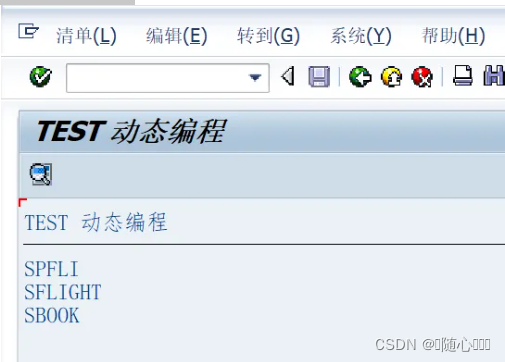
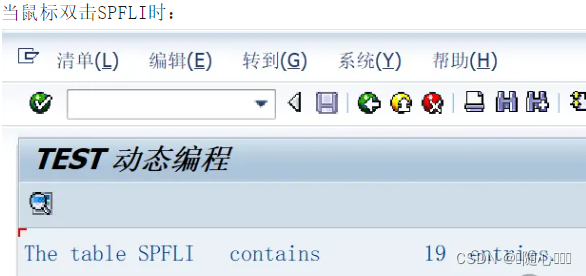
在这个例子中,用户可以通过界面选择一个表名,程序会根据用户的选择动态构建SQL语句,并执行查询。
案例二:动态SELECT和GROUP BY子句
问题描述:用户需要根据选择的列和聚合条件,动态生成报表。
解决方案:通过动态Open SQL,我们可以在运行时动态构建SELECT和GROUP BY子句,以满足用户的需求。
程序代码:
type-pools abap.parameters: lt radiobutton group 1 default 'X',gt radiobutton group 1,value type i.data: begin of wa,
count type i.
include type spfli.
data: end of wa.data: checked,
name type fieldname,
lines type i,descr_ref type ref to cl_abap_structdescr,sel_list type table of edpline,group_list type table of edpline,
having type string.field-symbols: <fs> type any,<comp_wa> type abap_compdescr.start-of-selection.set pf-status 'MAIN'.* get all components of table 'SPFLI'descr_ref ?=cl_abap_typedescr=>describe_by_name( 'SPFLI' ).loop at descr_ref->components assigning <comp_wa>.
name = <comp_wa>-name.write: / checked as checkbox, name.endloop.
lines = lines( descr_ref->components ).at user-command.* determine selected columns
clear: sel_list, group_list.append 'count(*) as count' to sel_list.
do lines times.
read line sy-index field value checked.
if checked = 'X'.
read line sy-index field value name.append name to: sel_list, group_list.endif.enddo.* determine operator
if gt = 'X'.
having = 'count(*) > value'.else.
having = 'count(*) < value'.endif.select (sel_list)
from spfli up to 20 rows
into corresponding fields of wa
group by (group_list)having (having). * write all components to listwrite: / wa-count.
loop at group_list into name.assign component name of structure wa to <fs>.write: <fs>.endloop.endselect.在程序代码16、17行中,
16 sel_list type table of edpline,
17 group_list type table of edpline,
声明了两个内部表——sel_list和group_list——来保存动态SELECT和
GROUP BY子句的源代码:
代码的41到48行,在用户命令事件中,count()被添加到SELECT列表中作为第一个字段。别名count与工作区wa的组件count匹配。然后,从列表中提取复选框的值来确定所选的列。为此,我们循环遍历列表,并根据复选框的值将所选列的名称附加到sel_list和group_list中。因为SELECT列表包含聚合函数count(),所以我们必须在sel_list和group_list中包含所有列标识符:
41 append 'count(*) as count' to sel_list.
42 do lines times.
43 read line sy-index field value checked.
44 if checked = 'X'.
45 read line sy-index field value name.
46 append name to: sel_list, group_list.
47 endif.
48 enddo.接下来,根据group_list对数据进行分组,并根据having_clause
过滤中间结果集:57 select (sel_list)
58 from spfli up to 20 rows
59 into corresponding fields of wa
60 group by (group_list)
61 having (having).最后,将结果集按列显示:
63 * 写所有组件到列表
64 write: / wa-count.
65 loop at group_list into name.
66 assign component name of structure wa to <fs>.
67 write: <fs>.
68 endloop.
69 endselect.为了成功执行,程序必须有一个GUI状态“MAIN”,它定义了一个带有功能代码“ONLI”的按钮,如下图:
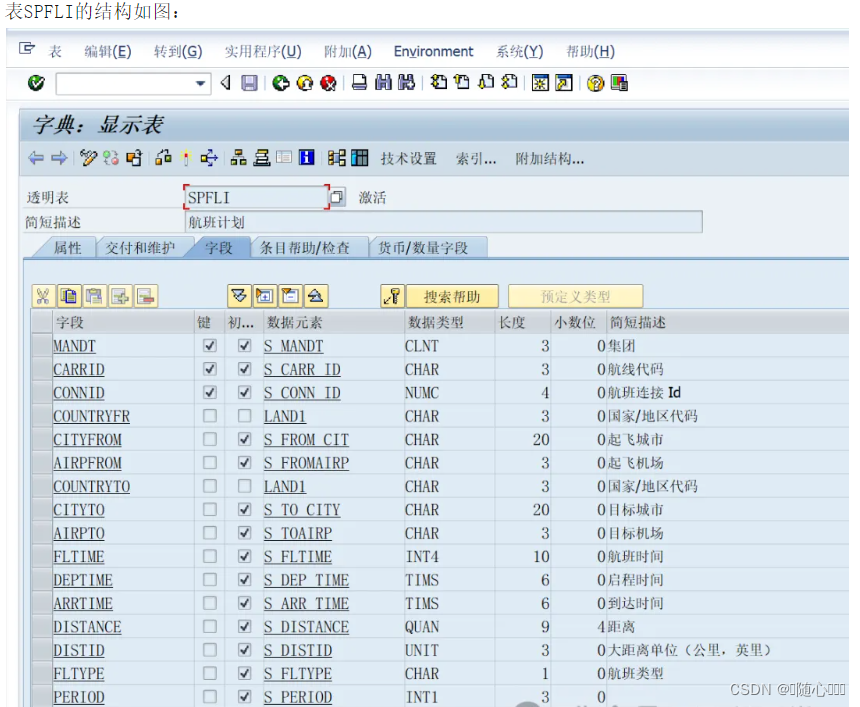
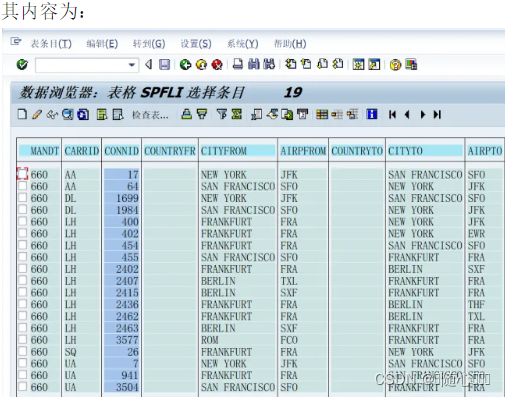
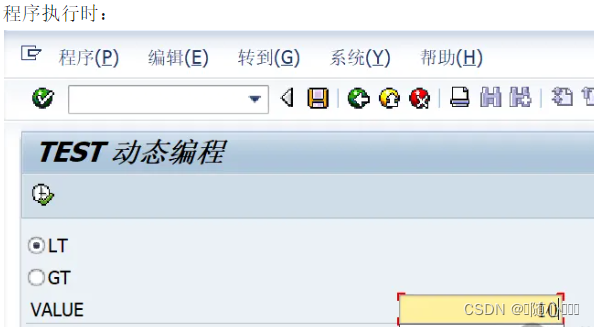
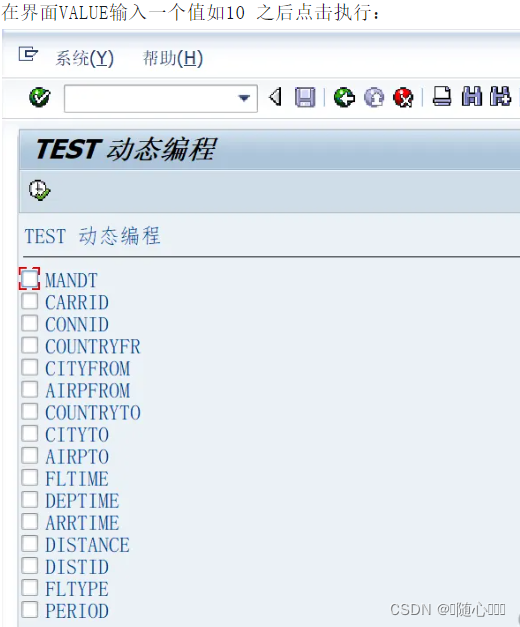

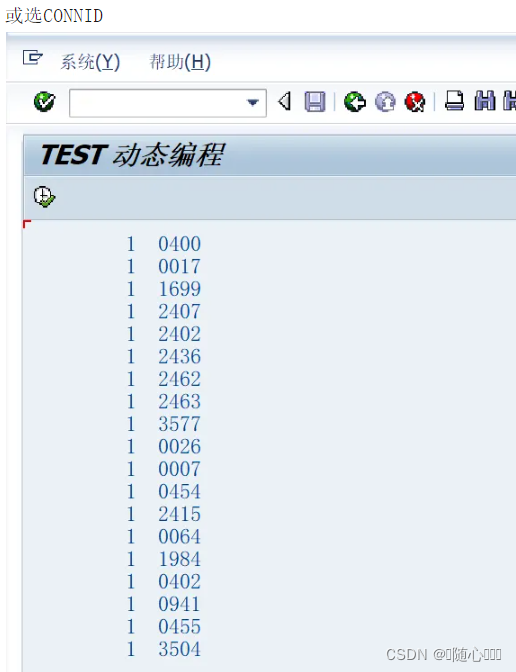
-
总之,结果随勾选字段的不同而不同。
-
在这个例子中,用户可以在界面上选择要包含在报表中的列,并设置聚合条件。程序会根据用户的选择动态构建SQL语句,并执行查询,生成报表。
-
动态Open SQL提供了一种强大的方法来处理在编译时无法确定的数据库访问问题,适合解决大多数需要通用数据库访问的编程情况。大多数Open SQL语句的子句——表名、SELECT、WHERE、GROUP BY、HAVING和ORDER BY——都可以动态指定。通过动态构建SQL语句的各个部分,我们可以编写出更加灵活和适应性强的ABAP程序。这种方法提高了代码的效率和可维护性。



















